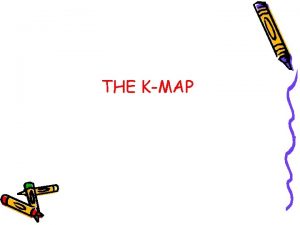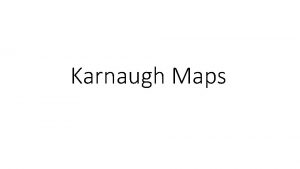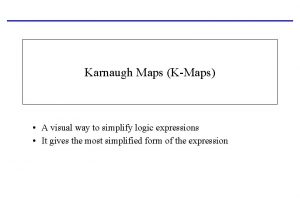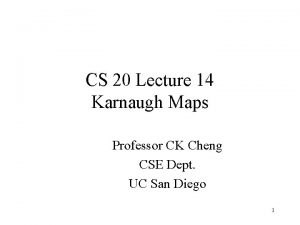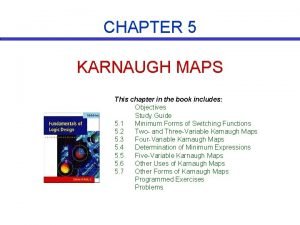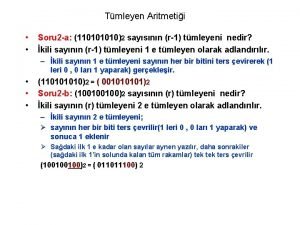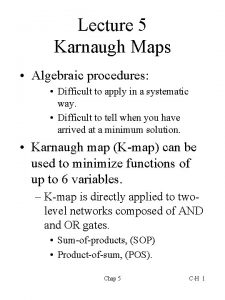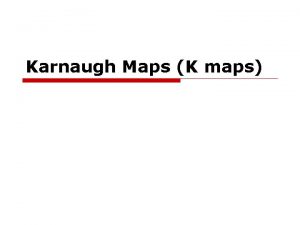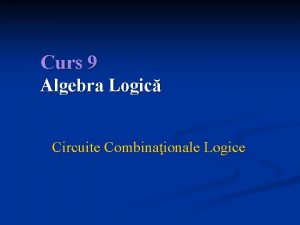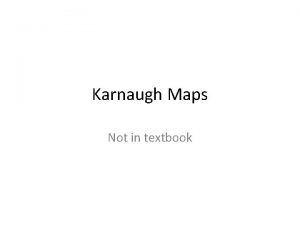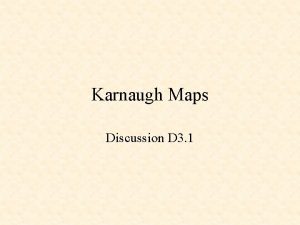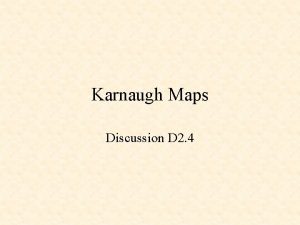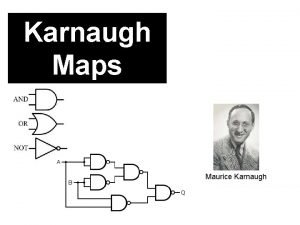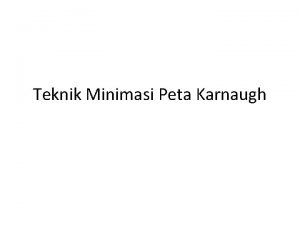Karnaugh Maps Karnaugh Maps Karnaugh maps Kmaps are

















- Slides: 17

Karnaugh Maps

Karnaugh Maps • Karnaugh maps (K-maps) are graphical representations of boolean functions. • One map cell corresponds to a row in the truth table. • Also, one map cell corresponds to a minterm or a maxterm in the boolean expression • Multiple-cell areas of the map correspond to standard terms.

Definitions • Minterm: A product term in which all the variables appear exactly once, either complemented or uncomplemented. Ex: ABC, A’B’C, ABC’ etc. • Maxterm: A sum term in which all the variables appear exactly once, either complemented or uncomplemented. Ex : A+B+C, A’+B’+C, A+B+C’ etc.

Truth Table notation for Minterms and Maxterms • Minterms and Maxterms are easy to denote using a truth table. • Example: Assume 3 variables x, y, z (order is fixed) x y z Minterm Maxterm 0 0 0 x’y’z’ = m 0 x+y+z = M 0 0 0 1 x’y’z = m 1 x+y+z’ = M 1 0 x’yz’ = m 2 x+y’+z = M 2 0 1 1 x’yz = m 3 x+y’+z’= M 3 1 0 0 xy’z’ = m 4 x’+y+z = M 4 1 0 1 xy’z = m 5 x’+y+z’ = M 5 1 1 0 xyz’ = m 6 x’+y’+z = M 6 1 1 1 x’+y’+z’ = M 7 xyz = m 7

Shorthand: ∑ and ∏ • f 1(a, b, c) = ∑ m(1, 2, 4, 6), where ∑ indicates that this is a sum-ofproducts form, and m(1, 2, 4, 6) indicates that the minterms to be included are m 1, m 2, m 4, and m 6. • f 1(a, b, c) = ∏ M(0, 3, 5, 7), where ∏ indicates that this is a product-ofsums form, and M(0, 3, 5, 7) indicates that the maxterms to be included are M 0, M 3, M 5, and M 7. • Since mj = Mj’ for any j, ∑ m(1, 2, 4, 6) = ∏ M(0, 3, 5, 7) = f 1(a, b, c)

Minimization as SOP using K-map Minimization of POS using K-map • Enter 1 s in the K-map for each product term in the function • Group adjacent K-map cells containing 1 s to obtain a product with fewer variables. Group size must be in power of 2 (2, 4, 8, …) • Enter 0’s in the K-map for each sum term in the function • Group adjacent K-map cells containing 0’s to obtain a sum with fewer variables. Group size must be in power of 2 (2, 4, 8, …) • Handle “boundary wrap” for K-maps of 3 or more variables.

SOP 2 variable K-maps There are 4 cells (2↑ 2) in the 2 -variable k-map. The following table shows the positions of all the possible outputs of 2 variable Boolean function on a K-map.

3 variable K-maps For a 3 -variable Boolean function, there is a possibility of 8 output min terms. The general representation of all the min terms using 3 variables is shown below.

A typical plot of a 3 -variable K-map is shown below.

4 variable K-maps There are 16 possible min terms in case of a 4 -variable Boolean function. The general representation of minterms using 4 variables is shown below.

Four-variable Map Simplification • One square represents a minterm of 4 literals. • A rectangle of 2 adjacent squares(pair) represents a product term of 3 literals as a pair removes one variable which change its state. • A rectangle of 4 squares(quad) represents a product term of 2 literals as a quad removes two variables which change its state. • A rectangle of 8 squares(Octet) represents a product term of 1 literal as it removes 3 variables that are changing their states.

POSSIBILITIES WHILE GROUPING OVERLAPPING GROUPS

2 variable k-map Example Simplify the given 2 -variable Boolean equation by using K-map. F = X Y’ + X’ Y + X’Y’ First, let’s construct the truth table for the given equation, We put 1 at the output terms given in equation. Reduced equation will be X’ +Y’.

3 variable k-map Given function, F = Σ (1, 2, 3, 4, 5, 6) First we need to look for an octet i. e. 8 adjacent 1′s. There is none, so we should now look for a quad i. e. 4 adjacent 1′s. Again, there is none, so we will look for pairs. There are 3 pairs circled in red. (1, 3) – A’C (Since B is the changing variable between these two cells, it is eliminated) (2, 6) – BC’ (Since A is the changing variable, it is eliminated) (4, 5) – AB’ (Since C is the changing variable, it is eliminated) Thus, F = A’C + BC’ + AB’

4 varible map

4 Variable map POS

Expected type of Questions 1. Obtain a simplified form for a Boolean expression: F(U, V, W, Z)=∏(0, 1, 3, 5, 6, 7, 10, 14, 15) 2. Reduce the following Boolean expression using K-Map: F(A, B, C, D)=∑(0, 1, 2, 4, 5, 6, 8, 10) 3. Reduce the following Boolean expression using K-Map: F(P, Q, R, S)= ∑(1, 2, 3, 4, 5, 6, 7, 8, 10) 4. Obtain a simplified form for a Boolean expression using K-Map: F(U, V, W, Z)=∏(5, 6, 7, 8, 9, 12, 13, 14, 15)

